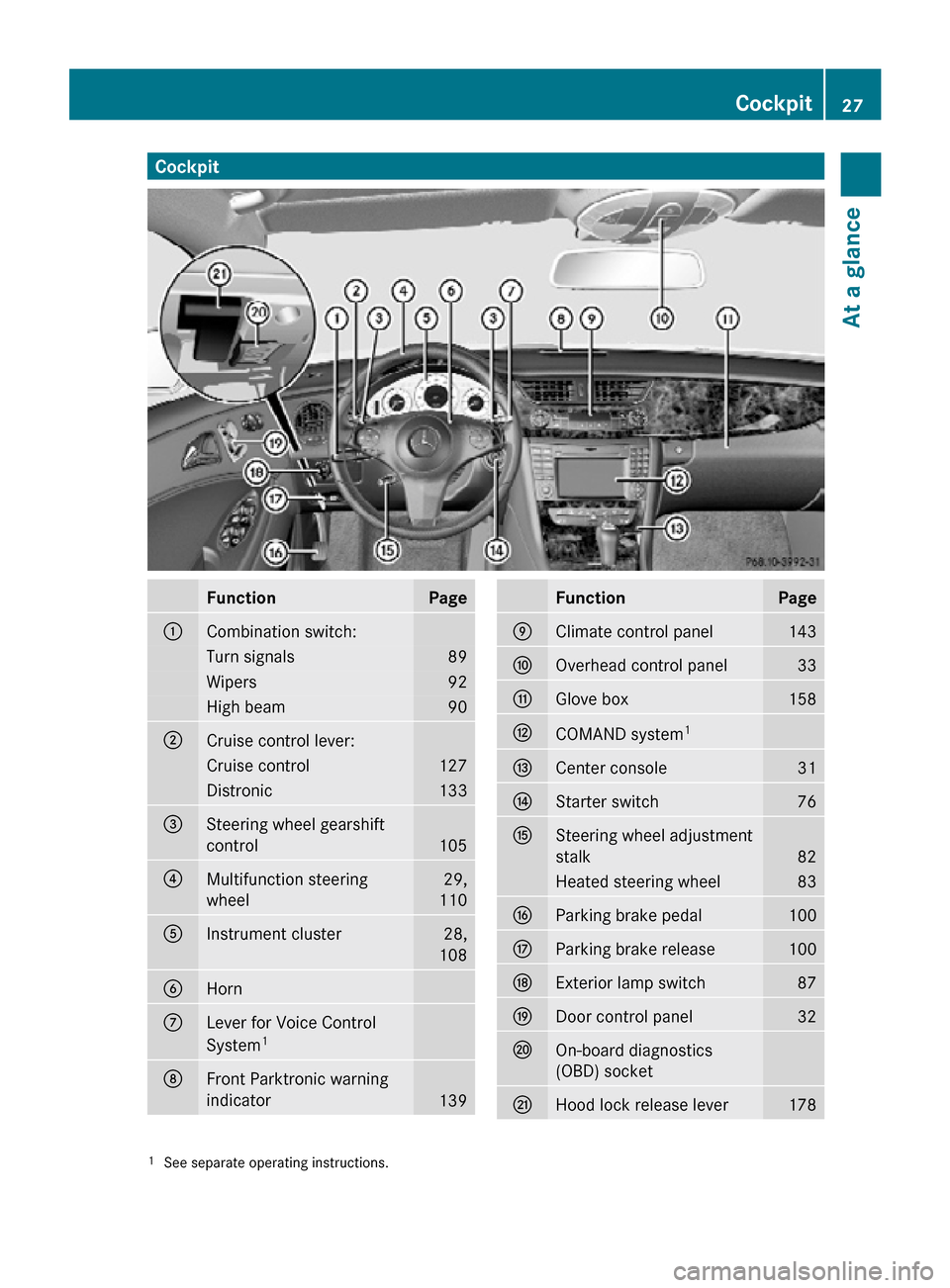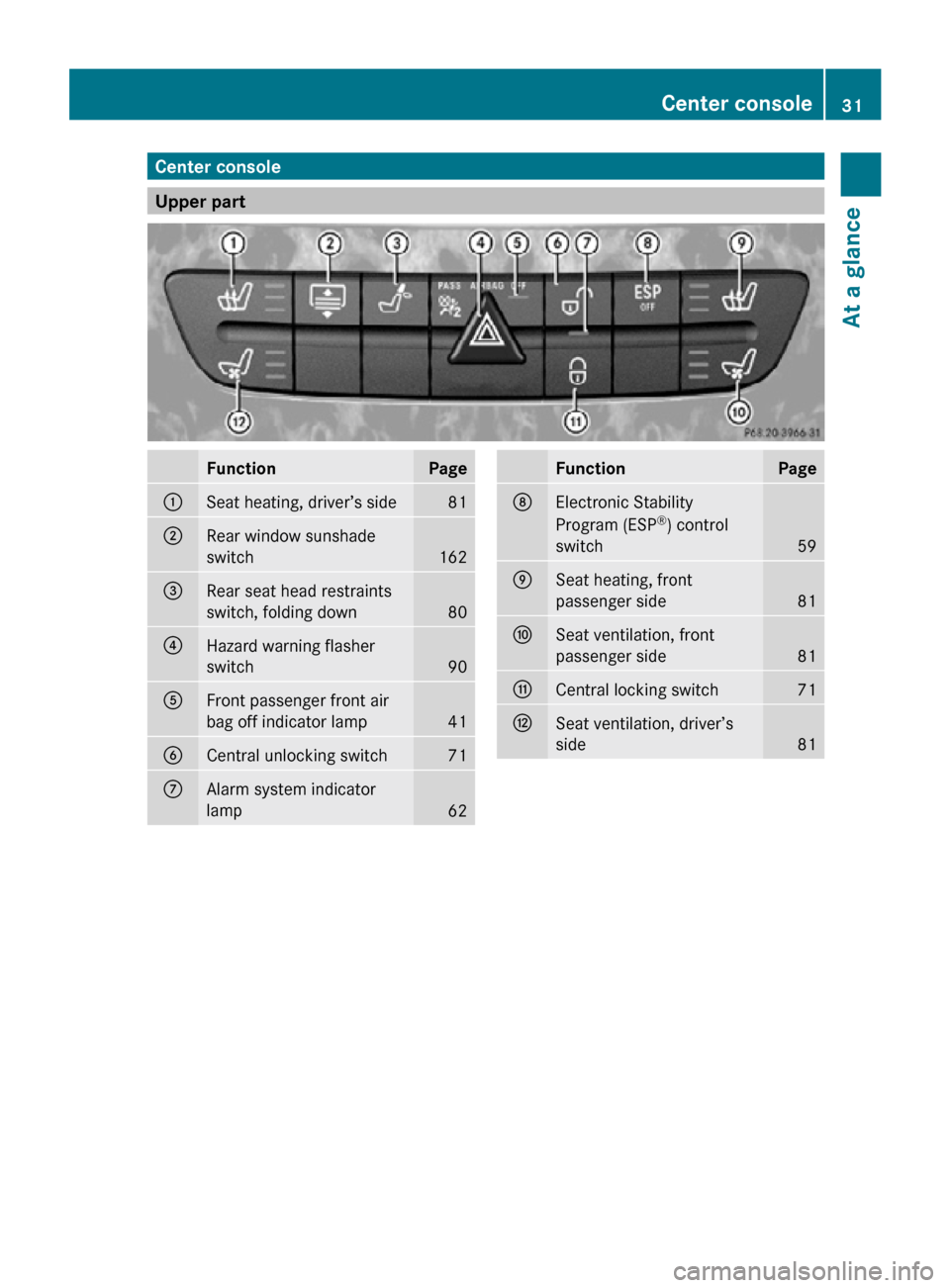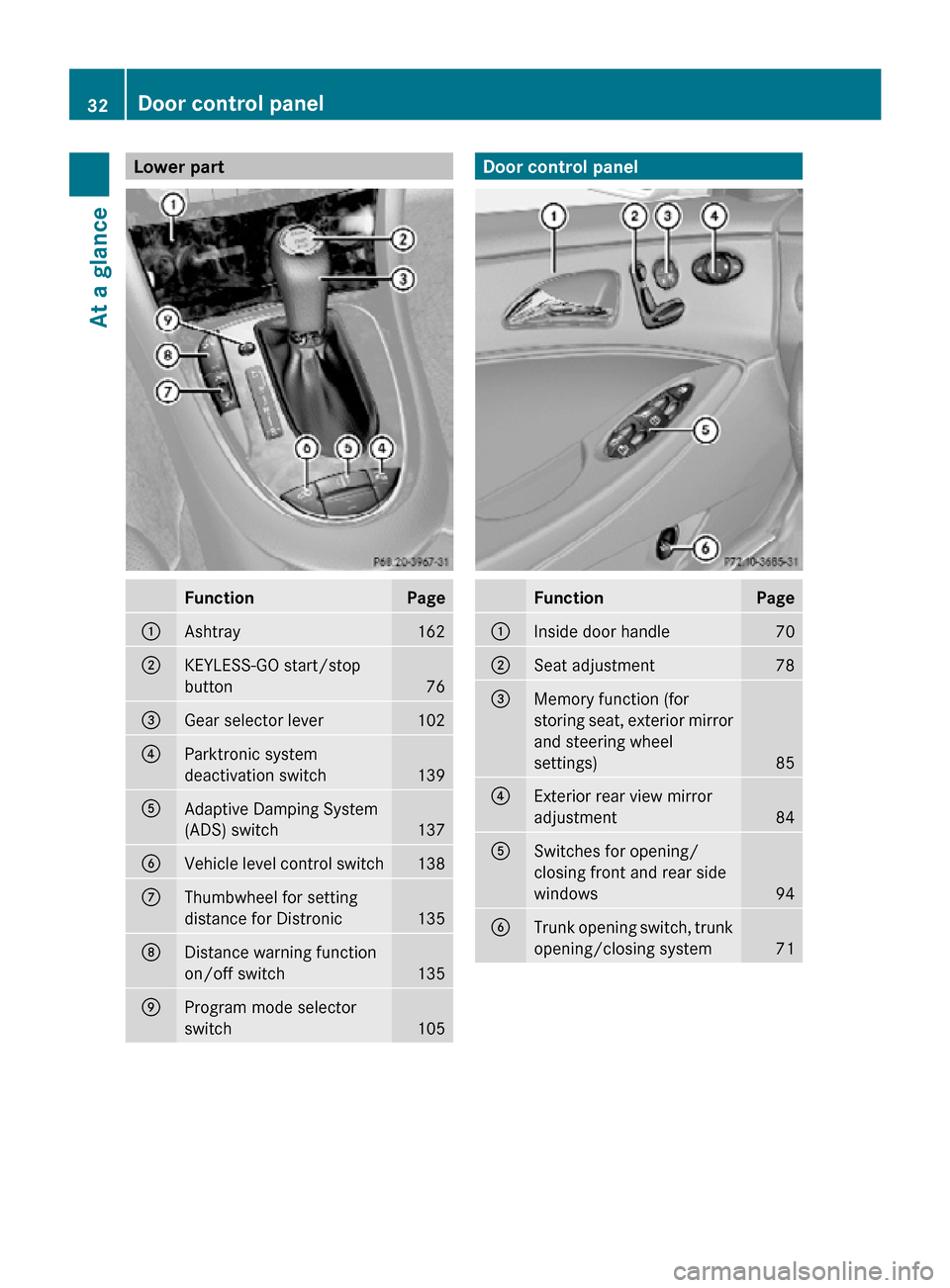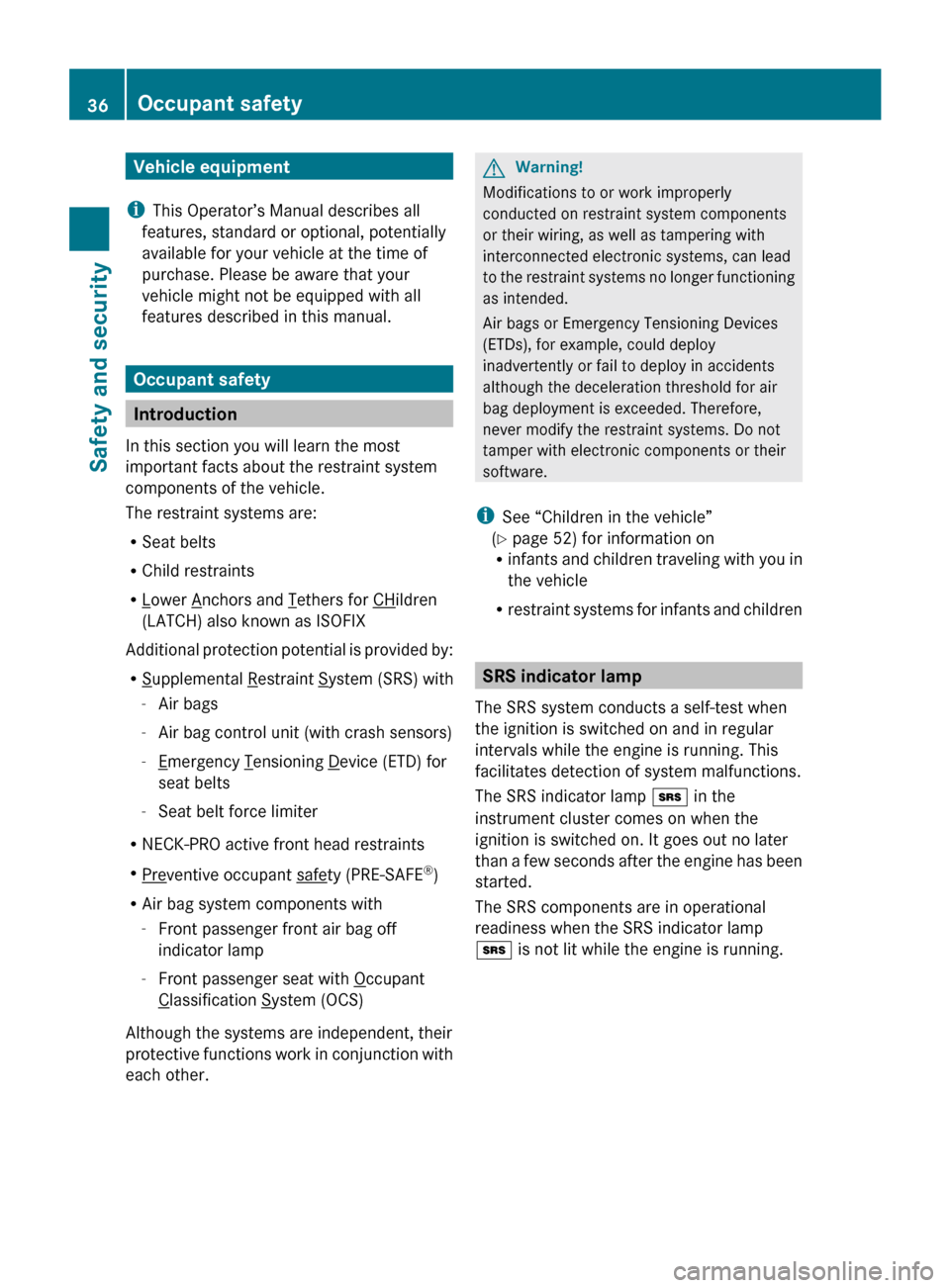2010 MERCEDES-BENZ CLS550 warning
[x] Cancel search: warningPage 29 of 308

Cockpit
Function Page
:
Combination switch:
Turn signals 89
Wipers 92
High beam 90
;
Cruise control lever:
Cruise control 127
Distronic 133
=
Steering wheel gearshift
control
105
?
Multifunction steering
wheel 29,
110 A
Instrument cluster 28,
108 B
Horn
C
Lever for Voice Control
System
1 D
Front Parktronic warning
indicator
139 Function Page
E
Climate control panel 143
F
Overhead control panel 33
G
Glove box 158
H
COMAND system
1 I
Center console 31
J
Starter switch 76
K
Steering wheel adjustment
stalk
82
Heated steering wheel 83
L
Parking brake pedal 100
M
Parking brake release 100
N
Exterior lamp switch 87
O
Door control panel 32
P
On-board diagnostics
(OBD) socket
Q
Hood lock release lever 178
1
See separate operating instructions. Cockpit
27At a glance
219_AKB; 4; 54, en-US
d2ureepe, Version: 2.11.8.1 2009-05-11T16:21:02+02:00 - Seite 27 Z
Page 30 of 308

Instrument cluster
Function Page
:
# Left turn signal
indicator lamp
;
d ESP
®
warning lamp 255
=
Speedometer
?
Multifunction display 111
A
· Distance warning
lamp
2 256
B
! Right turn signal
indicator lamp
C
Coolant temperature
indicator
109
? Coolant temperature
warning lamp
257
D
Tachometer with:
+ Supplemental
Restraint System (SRS)
indicator lamp
254 Function Page
! Antilock Brake
System (ABS) indicator
lamp
252
7 Seat belt telltale
253
K High-beam headlamp
indicator lamp
89
L Low-beam headlamp
indicator lamp
87
E
Main odometer with:
Transmission position
indicator
103
Program mode 105
F
Clock with:
$ Brake warning lamp,
USA only
252
J Brake warning lamp,
Canada only
252
= Engine malfunction
indicator lamp, USA only
257
2
Vehicles without Distronic: Warning lamp without function. It illuminates when the ignition is on. It should
go out when the engine is running. 28
Instrument clusterAt a glance
219_AKB; 4; 54, en-US
d2ureepe,
Version: 2.11.8.1 2009-05-11T16:21:02+02:00 - Seite 28
Page 31 of 308

Function Page
; Engine malfunction
indicator lamp, Canada only
257
h Combination low tire
pressure/TPMS
malfunction telltale, USA
only
188,
259 h Low tire pressure
telltale, Canada only
190,
259 G
Fuel display with:
6 Fuel tank reserve
warning lamp
256
H
Reset button for:
Resetting trip odometer 110
Adjusting instrument
cluster illumination
109 Multifunction steering wheel
Function Page
:
Multifunction display 111
;
Press button 6:
to answer a call 125
to dial
3 125
to redial
3 125
Press button ~:
to end a call 125
to reject an incoming call 125
Press button
W or X: to select submenus in the
Settings menu
119
to set values
to operate the RACETIMER
4 114
to set the volume
=
Press button V or U
to select next/previous
menu 110
3
Function only available in telephone menu.
4 AMG vehicles only. Multifunction steering wheel
29At a glance
219_AKB; 4; 54, en-US
d2ureepe, Version: 2.11.8.1 2009-05-11T16:21:02+02:00 - Seite 29 Z
Page 33 of 308

Center console
Upper part
Function Page
:
Seat heating, driver’s side 81
;
Rear window sunshade
switch
162
=
Rear seat head restraints
switch, folding down
80
?
Hazard warning flasher
switch
90
A
Front passenger front air
bag off indicator lamp
41
B
Central unlocking switch 71
C
Alarm system indicator
lamp
62 Function Page
D
Electronic Stability
Program (ESP
®
) control
switch 59
E
Seat heating, front
passenger side
81
F
Seat ventilation, front
passenger side
81
G
Central locking switch 71
H
Seat ventilation, driver’s
side
81Center console
31At a glance
219_AKB; 4; 54, en-US
d2ureepe, Version: 2.11.8.1 2009-05-11T16:21:02+02:00 - Seite 31 Z
Page 34 of 308

Lower part
Function Page
:
Ashtray 162
;
KEYLESS-GO start/stop
button
76
=
Gear selector lever 102
?
Parktronic system
deactivation switch
139
A
Adaptive Damping System
(ADS) switch
137
B
Vehicle level control switch 138
C
Thumbwheel for setting
distance for Distronic
135
D
Distance warning function
on/off switch
135
E
Program mode selector
switch
105 Door control panel
Function Page
:
Inside door handle 70
;
Seat adjustment 78
=
Memory function (for
storing seat, exterior mirror
and steering wheel
settings)
85
?
Exterior rear view mirror
adjustment
84
A
Switches for opening/
closing front and rear side
windows
94
B
Trunk opening switch, trunk
opening/closing system
7132
Door control panelAt a glance
219_AKB; 4; 54, en-US
d2ureepe,
Version: 2.11.8.1 2009-05-11T16:21:02+02:00 - Seite 32
Page 38 of 308

Vehicle equipment
i This Operator’s Manual describes all
features, standard or optional, potentially
available for your vehicle at the time of
purchase. Please be aware that your
vehicle might not be equipped with all
features described in this manual. Occupant safety
Introduction
In this section you will learn the most
important facts about the restraint system
components of the vehicle.
The restraint systems are:
R Seat belts
R Child restraints
R Lower Anchors and Tethers for CHildren
(LATCH) also known as ISOFIX
Additional
protection potential is provided by:
R Supplemental Restraint System (SRS) with
- Air bags
- Air bag control unit (with crash sensors)
- Emergency Tensioning Device (ETD) for
seat belts
- Seat belt force limiter
R NECK-PRO active front head restraints
R Preventive occupant safety (PRE-SAFE
®
)
R Air bag system components with
-Front passenger front air bag off
indicator lamp
- Front passenger seat with Occupant
Classification System (OCS)
Although the systems are independent, their
protective
functions work in conjunction with
each other. G
Warning!
Modifications to or work improperly
conducted on restraint system components
or their wiring, as well as tampering with
interconnected electronic systems, can lead
to
the restraint systems no longer functioning
as intended.
Air bags or Emergency Tensioning Devices
(ETDs), for example, could deploy
inadvertently or fail to deploy in accidents
although the deceleration threshold for air
bag deployment is exceeded. Therefore,
never modify the restraint systems. Do not
tamper with electronic components or their
software.
i See “Children in the vehicle”
(Y page 52) for information on
R infants and children traveling with you in
the vehicle
R restraint systems for infants and children SRS indicator lamp
The SRS system conducts a self-test when
the ignition is switched on and in regular
intervals while the engine is running. This
facilitates detection of system malfunctions.
The SRS indicator lamp + in the
instrument cluster comes on when the
ignition is switched on. It goes out no later
than
a few seconds after the engine has been
started.
The SRS components are in operational
readiness when the SRS indicator lamp
+ is not lit while the engine is running. 36
Occupant safety
Safety and security
219_AKB; 4; 54, en-US
d2ureepe,
Version: 2.11.8.1 2009-05-11T16:21:02+02:00 - Seite 36
Page 39 of 308

G
Warning!
The SRS self-check has detected a
malfunction when the SRS indicator lamp
+
R does not come on at all
R fails to go out after approximately
4 seconds after the engine was started
R comes on after the engine was started or
while driving
For
your safety, we strongly recommend that
you contact an authorized Mercedes-Benz
Center immediately to have the system
checked. Otherwise the SRS may not be
activated when needed in an accident, which
could result in serious or fatal injury. The SRS
might also deploy unexpectedly and
unnecessarily which could also result in injury
as well.
In addition, improper work on the SRS creates
a risk of rendering the SRS inoperative or
causing unintended air bag deployment. Work
on the SRS must therefore only be performed
by qualified technicians. Contact an
authorized Mercedes-Benz Center.
If it is necessary to modify an air bag system
to accommodate a person with disabilities,
contact an authorized Mercedes-Benz Center.
USA only: Call our Customer Assistance
Center at 1-800-FOR-MERCedes
(1-800-367-6372) for details. Air bags
G
Warning!
Air bags are designed to reduce the potential
of injury and fatality in certain
R frontal impacts (front air bags and driver’s
side knee bag)
R side impacts (side impact air bags and
window curtain air bags)
R rollovers (window curtain air bags) However, no system available today can
completely eliminate injuries and fatalities.
Deployment of the air bags temporarily
releases a small amount of dust from the air
bags. This dust, however, is neither harmful
to
your health, nor does it indicate a fire in the
vehicle. The dust might cause some
temporary breathing difficulty for people with
asthma or other breathing trouble. To avoid
this, you may wish to get out of the vehicle as
soon as it is safe to do so. If you have any
breathing difficulty but cannot get out of the
vehicle after the air bag inflates, then get fresh
air by opening a window or door. G
Warning!
To reduce the risk of injury when the front air
bags
inflate, it is very important for the driver
and front passenger to always be in a properly
seated position and to wear their respective
seat belt.
For maximum protection in the event of a
collision always be in normal seated position
with your back against the seat backrest.
Fasten your seat belt and make sure it is
properly positioned on your body.
Since the air bag inflates with considerable
speed and force, a proper seating position
and correct positioning of the hands on the
steering wheel will help to keep you at a safe
distance from the air bag. Occupants who are
not wearing their seat belt, are not seated
properly or are too close to the air bag can be
seriously injured or killed by an air bag as it
inflates with great force instantaneously:
R Sit with the seat belt properly fastened in a
position that is as upright as possible with
your back against the seat backrest.
R Move the driver’s seat as far back as
possible, still permitting proper operation
of vehicle controls. The distance from the
center of the driver’s chest to the center of
the air bag cover on the steering wheel
must be at least 10 inches (25 cm) or more.
You should be able to accomplish this by Occupant safety
37
Safety and security
219_AKB; 4; 54, en-US
d2ureepe, Version: 2.11.8.1 2009-05-11T16:21:02+02:00 - Seite 37 Z
Page 40 of 308

adjusting the seat and steering wheel. If
you
have any difficulties, please contact an
authorized Mercedes-Benz Center.
R Do not lean your head or chest close to the
steering wheel or dashboard.
R Keep hands on the outside of the steering
wheel rim. Placing hands and arms inside
the rim can increase the risk and potential
severity of hand/arm injury when the driver
front air bag inflates.
R Adjust the front passenger seat as far as
possible rearward from the dashboard
when the seat is occupied.
R Occupants, especially children, should
never place their bodies or lean their heads
in the area of the door where the side
impact air bag inflates. This could result in
serious injuries or death should the side
impact air bag be deployed. Always sit as
upright as possible, wear the seat belt
properly and use an appropriately sized
infant restraint, toddler restraint, or
booster seat recommended for the size and
weight of the child.
Failure to follow these instructions can result
in severe injuries to you or other occupants.
If you sell your vehicle, it is important that you
make the buyer aware of this safety
information. Be sure to give the buyer this
Operator’s Manual. G
Warning!
Accident research shows that the safest place
for
children in an automobile is in a rear seat.
There is a possibility for a side impact air bag-
related injury if occupants, especially
children, are not properly seated or restrained
when next to a side impact air bag which
needs to deploy rapidly in a side impact in
order to do its job.
To help avoid the possibility of injury, please
follow these guidelines:
(1) Occupants, especially children, should
never place their bodies or lean their heads in the area of the
door
where the side impact air bag
inflates. This could result in
serious injuries or death should
the side impact air bag be
deployed.
(2) Always sit as upright as possible, wear
the seat belt properly and use
an appropriately sized infant
restraint, toddler restraint, or
booster seat recommended for the
size and weight of the child. and
for children 12 years old and
under, use an appropriately sized
infant restraint, toddler restraint,
or booster seat recommended for
the size and weight of the child.
(3) Always wear seat belts properly.
If you believe that, even with the use of these
guidelines,
it would be safer for your rear seat
occupants to have the rear mounted side
impact air bags deactivated, then
deactivation can be carried out upon your
written request at an authorized Mercedes-
Benz Center at an additional cost.
Please contact an authorized Mercedes-Benz
Center or call the Customer Assistance
Center (in the USA) at 1-800-FOR-MERCedes
(1-800-367-6372), or Customer Service (in
Canada) at 1-800-387-0100 for details.
Air bags are designed to deploy only in certain
R frontal impacts (front air bags and driver’s
side knee bag)
R side impacts (side impact and window
curtain air bags) if the system determines
the need for air bag deployment
R rollovers (window curtain air bags)
Only in the event of such a situation will they
provide their supplemental protection.
The driver and passengers should always
wear their seat belts. Otherwise it is not
possible for the air bags to provide their
supplemental protection. 38
Occupant safety
Safety and security
219_AKB; 4; 54, en-US
d2ureepe,
Version: 2.11.8.1 2009-05-11T16:21:02+02:00 - Seite 38